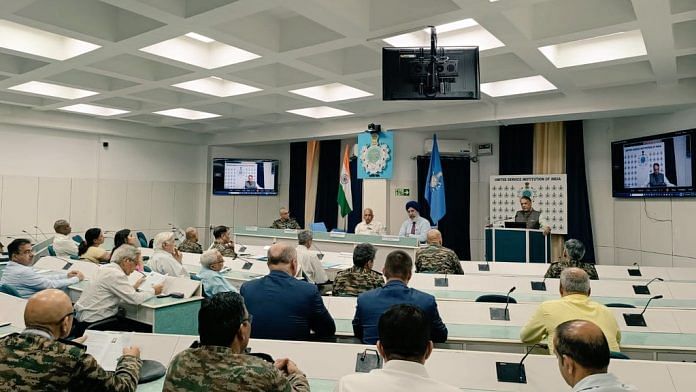As if India’s security scenario was so sanguine that the Army has embarked on a long voyage into the past to unearth, or rather highlight, ‘indigenous military systems…strategic thought processes that have governed the land for millennia’.
‘Project Udbhav’ is a joint effort of the Shimla-based Army Training Command (ARTRAC) and Delhi’s venerable United Service Institution of India. The USI is officially India’s first defence services and security-related think-tank. The project held its first seminar on 29 September, chaired by Lt Gen Vinod Khandare (retd), an adviser at the Ministry of Defence, and keynote address delivered by Lt Gen Raju Bail, director general, strategic planning, Army HQs.
The study of Indian classics, seen as the fount of indigenous wisdom, is at the core of ‘Project Udbhav’, with a particular emphasis on three ancient texts—Kautilya’s Arthashastra, Kamandaka’s Nitisara, and Thiruvalluvar’s Kural. It is believed that these texts, each following a chronological evolutionary order, contain knowledge to tackle India’s security issues and problems, at least as far as an army is concerned. Presuming, of course, that the Indian Army has been intellectually idle all along. Udbhav, meaning evolution, underlines the purpose of the effort. The political root, however, is to ‘shed vestiges of the colonial era’.
This is a new formulation largely expressed by political authorities but has lately been taken up with gusto by senior military leadership. And as the largest among the three Services, this is more visible as an Army effort, although even the most tradition-bound Navy hasn’t been found lacking in displaying efforts at nativity either. The political purpose can easily be understood as yet another step in the complete makeover of India, thus mirroring the peculiar self-image perpetuated over the decades. However, the military’s participation in this enterprise is difficult to fathom since the armed forces of India aren’t entirely a colonial creation.
Also read: Army launches Project Udbhav to ‘rediscover profound Indic heritage of statecraft, warfare’
A wasteful exercise
A stone’s throw from ARTRAC Headquarters is the Army Heritage Museum, which declares that India’s ‘rich tradition is more than 5,000 years old’, and the objects on display are categorised variously as Army and the nation, Army ethos, ancient military thinking, inspirational military leaders, uniforms, flags, military music, and bands. This is one of the busiest military museums in the country. As is obvious, ample attention has been paid to India’s military heritage and thinking. There is just the right mixture of ethos and philosophy, so it is perplexing that an active formation needs to be engaged with a task such as ‘Project Udbhav’.
The Army Heritage Museum’s beautiful area has a name to match as well, Annandale or Annadale, depending on the Scottish or English preference of the reader. Which, of course, isn’t kosher when ‘vestiges of the colonial era’ are sought to be eradicated. ARTRAC HQ occupies a building in the Shimla Mall, which was constructed in the 1880s, and has been impeccably maintained. The ARTRAC Alpha Mess was originally called Will Hall and later renamed to Knockdrin, while the Command House, residence of the General Officer Commanding-in-Chief, at Chaura Maidan, is the suitably titled Retreat. Chiselhurst is where the Shimla Station Commander resides.
The list goes on. But what should not be forgotten are displays at the Army Heritage Museum, which go back several millennia. An episode that lasted merely 200 years is barely a blip. In any case, the military should remain focused on the tasks on hand, because regardless of their brilliance, the ancient texts are no substitute for already existing précis and training manuals. ARTRAC philosophy is perfectly captured by the epithet: No soldier or officer should ever lose his life or limb in combat, because he was inadequately trained. That is the essence of training in the Indian Army.
Nowhere does the role, charter of duties, or any special Army order for ARTRAC say that there be a study of ‘strategic thought processes that have governed the land for millennia.’ Governance is not within the purview of military studies in India, and is unlikely to be. Hence, studying such processes is wasteful when the intellectual acumen of officers and veterans could be better utilised for issues of greater national security concern. In 2023, indigenous military technologies barely make the cut for the armed forces, so where does ‘profound depths of indigenous military systems’ fit into operational requirements?
Ancient texts are a testament to history and sociological development of India. The verses are more of a guide for good political leadership, although militarily important nuggets do appear. The Kural has three perpetually relevant verses: ‘But however strong a fortress may be, it will avail nothing if the defenders show not vigour in action’ (750); ‘Even if there is no lack of troops of the line, there is no army when there are no chiefs to lead’ (770); ‘If thou hast to contend alone and without allies against two enemies, try to gain over one of them to thy side’ (875).
Outstanding military research into Arthashastra and Nitisara has already been done by Col Pradeep Kumar Gautam (retd), an Army veteran currently affiliated with the Centre for Military History and Conflict Studies, USI. Simply put, ‘Both the texts deal with the acquisition of wealth and its distribution, with an emphasis on war as the last resort.’ It’s a far cry from ARTRAC’s primary task, but can be done when military history is accurately recounted — something the esteemed advisor Khandare erred on when he said Shivaji fought on five fronts including the British. Shivaji died in 1680, long before the British military threat emerged.
Manvendra Singh is a Congress leader, Editor-in-Chief of Defence & Security Alert and Chairman, Soldier Welfare Advisory Committee, Rajasthan. He tweets @ManvendraJasol. Views are personal.
(Edited by Prashant)



